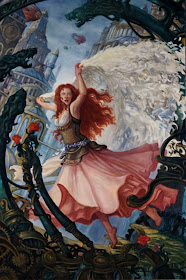I was kindly sent this press release this morning regarding In Media Res: A Creative Commons Project from an academic friend and thought I'd share, along with an excerpt from the first post which went live today.
First though, I thought I'd include some information from their "About" page so you can understand what In Media Res is trying to do. This sort of project is exactly the type of approach I've been hoping to see since social media became so prevalent, particularly in making scholarship accessible to non-academics and allowing for communication between scholars, media and interested non-academics, so this is very exciting.
In Media Res is dedicated to experimenting with collaborative, multi-modal forms of online scholarship. Our goal is to promote an online dialogue amongst scholars and the public about contemporary approaches to studying media. In Media Res provides a forum for more immediate critical engagement with media at a pace closer to how we experience mediated texts.
 |
| Persephone by Kristina Carroll |
Each weekday, a different scholar curates a 30-second to 3-minute video clip/visual image slideshow accompanied by a 300-350-word impressionistic response. We use the title "curator" because, like a curator in a museum, you are repurposing a media object that already exists and providing context through your commentary, which frames the object in a particular way. The clip/comment combination are intended both to introduce the curator’s work to the larger community of scholars (as well as non-academics who frequent the site) and, hopefully, encourage feedback/discussion from that community.
Theme weeks are designed to generate a networked conversation between curators. All the posts for theme weeks thematically overlap and the participating curators each agree to comment on one another’s work.
In Media Res hopes to:
• Give scholars the opportunity to critically engage with the media in a more immediate and timely way.
• Promote discussion within the media studies community through virtual interactions around contemporary media artifacts.
• Enable a lively debate in which the sum total of the conversation will be more valuable than any one particular voice.
• Bridge the divide between academic and non-academic communities, inviting a critically-engaged and/or curious public to join in.
• Lead to the emergence of new scholarly and pedagogical ideas about studying and teaching media.
• Work toward reinvigorating the academic’s role as public intellectual by presenting media scholars not just as informed experts with valuable ideas to impart about critical media literacy, but as fellow citizens in a mediated society.
We have both a Facebook group and Twitter feed that provide links to each day’s post and to the latest calls for curators.
If you are interested in being a video curator, please contact us at: alisa@mediacommons.futureofthebook.org
From In Media Res this week:
Monday, March 12, 2012 - Lindsey Kempton (Independent Scholar) presents: Fairy Tales And The Sophisticated Viewer
Tuesday, March 13, 2012 - Michael Besozzi (Georgia State University) presents: A Dream Walking: Desire and Fantasy in Catherine Breillat’s "The Sleeping Beauty"
Wednesday, March 14, 2012 - Amanda Landa (University of Texas at Austin) presents: Anime Fairy Tales: Fighting Fate and Convention
Thursday, March 15, 2012 - Mattie Tanner (University of Texas at Dallas) presents: The Root of Evil—ABC’s "Once Upon A Time" Makes Evil Characters More Human
Friday, March 16, 2012 - Lisa Schmidt (Bishop’s University) presents: Fairy Tales And The Sophisticated Viewer
Theme week organized by Maria Boyd (Georgia State University).
 |
| From "Pan's Labyrinth" |
Traditional fairy tale narratives are not made for today’s TV. Among a steady increase of smart, narratively complex shows that utilize attributes of the televisual medium, such as seriality and reflexivity, to their fullest, the conventional fairy tale falls flat. Their structures are too linear, too episodic, their worlds too limited, and their characters too static. At the very least, fairy tales’ self-contained stories and one dimensional protagonists would have to be altered to work for TV. But savvy contemporary TV audiences that embrace, and to a certain extent, expect complicated narratives would yawn at a simple retrofitting of the tales. More significant changes on a narrative and structural level are required to entertain today’s sophisticated viewers.
Fortunately, fairy tales have an inherent quality that makes them particularly amenable to adaptation. Spun from a long tradition of oral storytelling, fairy tale narratives are naturally fluid, easily allowing the stories to morph and evolve into whatever the storyteller desires so long as key narrative hallmarks remain recognizable. In part, it’s this fluidity that has allowed TV shows like Grimm and Once Upon A Time to mold the classic stories into a format fit for contemporary TV andTV audiences.You can continue reading HERE.
There are interesting links in the related content area of the page too, such as:


Once again, you bring information on something new and interesting in the world of fairy tales!
ReplyDelete